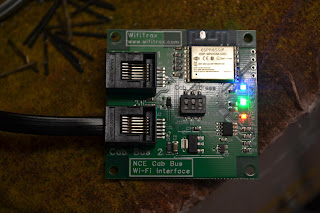This week my modelling activities were distracted by a
camera flash, at least on Tuesday, Wednesday and Thursday nights. I
wanted to model a TW taking photos on my layout. I thought that this
modelling project would be easy. The first thing I did was to talk to
Barnacle Bob and see what he used on his layout. Mosquito Creek has a
photographer supposedly taking a photo of a young lady sitting on a rocky
outcroft, when we know he is taking a photo of a train crossing the brilliantly
built trestle bridge with a train running across it. So Bob’s solution
was to purchase a WEISSMANN model. In the current environment, that would
cost truck loads from Europe to ship and conversion rates would send me
broke. Surely I could manufacture one myself. I thought about using
an NCE Mini Panel to send a signal to turn on an NCE light-it wait ¼ of a
second and then turn it off. My issues is that when I issue a turn it on
command to a light-it it is a slow turn on. The intensity of the light
ramps up over a second. Not an instantaneous ‘on’ like a flash from a
camera. I was going to detect the presence of a loco on a section of
track and via an NCE BD20 and then that would trigger a function on the mini
panel, which would activate the light-it sequence. I thought this would
be easy, but the cost of a BD20 was a slight stumbling block in my current
modelling budget and the slow turn on was the real killer. I think I
might have some 3rd party detectors in the cupboard that I might try
and see if they could trigger a Mini Panel input, in place of the NCE BD20, but
this solution looks dead and buried, especially when the turn on from the
light-it is rather a slow ramp up – not a simulated camera flash.
I had another solution. It was that the loco on the
track itself would just trigger power through a bridge rectifier to light an
LED. I have set it up so this solution works and will only trigger on a
powered axle, not each axle in a train. This is achieved by having
isolated sections longer than a wheel tread before and after the section
connected to the bridge rectifier. So in a test run, my 6 wheel loco will
fire off the camera 6 times, once for each powered wheelset. The flash
was quick to fire and then went out. A contributor to this short flash,
is that the section of track that is the trigger section is only about 4mm long
and the wheel on a moving train is quickly on and then off the trigger.
Sure a certified TW might take than many photos in quick succession for each
locomotive, but, ideally I’d like the circuit to fire maybe once or even twice
for each loco – maybe once per bogie. So I’d like the first wheel to fire
the camera, and then it would then charge a circuit that introduces a delay of
maybe 2 to 4 seconds before it resets. That way the camera will fire
maybe once per bogie or even once per locomotive, depending upon the speed it
is going through the section. Alternatively, the first wheel might charge
the circuit, which then the second or maybe third or fourth wheel will initiate
a camera flash, as the other wheels contribute to the charge.
I need the help of an electronics guru. I really don’t
want to spend $50 - $100 on a commercial product. Surely there are lots
of people who would like this gimmick on their layouts. My circuit
diagrams are below.
The other activities undertaken this weekend was watch the
NMRA-X event on Saturday night for a few hours before I bailed. I have
almost completed a presentation for an upcoming NMRA-X event. I built 26 more pallets and have 12 that been painted and added to the spares box.
I did revert to doing a little work on my QR HO
wagons by adding a small amount of weight between the centre sills on the first
two completed wagons. Maybe next week I will do some more on my 4 half bit QR HO wagons and maybe they will enter the paint shop as well.












